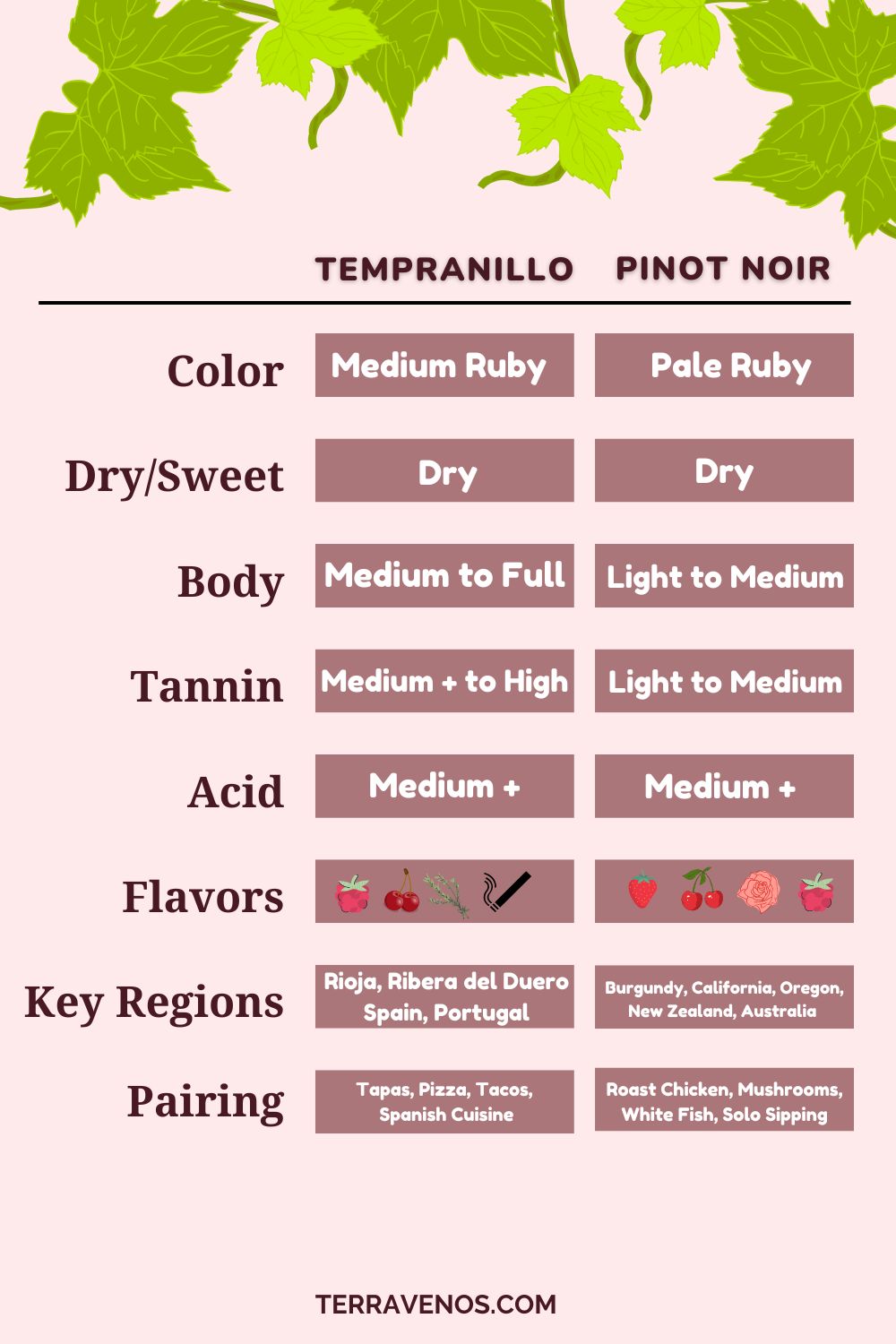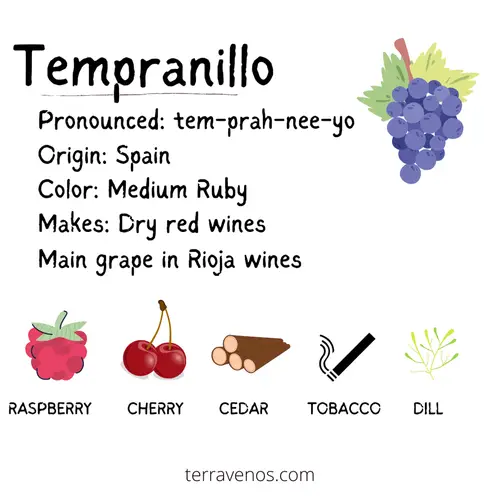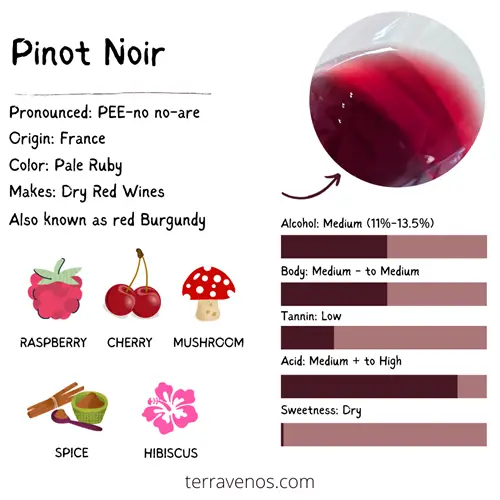
Tempranillo vs Pinot Noir are fun wines to compare.
Pinot Noir red fruit, a lighter body and higher acid than Tempranillo. Tempranillo has more tannins, red fruit, and tomato notes. Both wines are widely available.
Comparing Tempranillo vs Pinot Noir is a must-try side-by-side tasting for newer red wine enthusiasts. These are both popular red wines you’ll come across regularly.
Tempranillo Basics: Spain’s Red Wine

Tempranillo, a well-regarded grape originating from Spain, has gained worldwide recognition for its robust character. Now a global favorite, Tempranillo thrives in vineyards worldwide, from Spain’s Rioja and Ribera del Duero to New World regions.
With its deep crimson color, Tempranillo offers a palate of red berries complemented by subtle hints of vanilla and leather. This flavorful profile has made it popular among wine enthusiasts globally, securing its place in cellars.
Spain, the birthplace of Tempranillo, showcases its versatility from everyday wines to prestigious reserva and gran reserva selections.
Fun Wine Fact: Tempranillo gets its name from the Spanish word “temprano,” meaning early, as it usually ripens before many other grape varieties.
Helpful Tip: Here’s a complete guide to Tempranillo.

Pinot Noir Basics: Liquid Elegance

Pinot Noir is originally from the Burgundy region of France and today you’ll find wines made from Pinot Noir made around the world, including Oregon, California, Chile, New Zealand, and Australia. Pinot Noir is an aromatic red wine grape known for its red cherry and cranberry aromas, along with a floral profile. (Check out this comprehensive guide to Pinot Noir wines.)
Fun Wine Fact: Pinot Noir can go be Red Burgundy. If you ask for a Red Burgundy at a restaurant or wine shop, you’ll get a Pinot Noir.
Wine Comparison: Tempranillo vs Pinot Noir
Here’s a quick side-by-side comparison that covers the most common styles of Tempranillo and Pinot Noir:
| Characteristics | Tempranillo | Pinot Noir |
|---|---|---|
| Hue | Deep ruby to garnet | Pale to medium ruby |
| Color | Red | Red |
| Aromas | Red berries, plum, tomato, coconut | Cherry, strawberry, earthy |
| Tannins | Moderate to high | Low to moderate |
| Acid | Moderate | Moderate to high |
| Alcohol (%) | 13-15% | 12-15% |
| Body | Medium to full | Light to medium |
| Intensity | Moderate to pronounced | Moderate to Pronounced |
| Key Growing Regions | Spain (Rioja), Argentina, Portugal | France (Burgundy), USA, New Zealand |
| Classic Pairings | Grilled meats, chorizo, tapas | Duck, salmon, mushroom dishes |
| Price Range | $10-$50 | $15-$60 |
Tempranillo Wine Profile
- Sweetness: Tempranillo is typically produced in a dry style, offering minimal residual sugar.
- Alcohol: Tempranillo wines generally have a low to moderate alcohol content, ranging from around 12% to 14% ABV
- Acid: Tempranillo has medium acid.
- Body: Known for its medium to full body, the style of Tempranillo will depend on the growing region and winemaker.
- Tannins: Tempranillo has more pronounced tannins than Pinot Noir, in the medium to high range.
- Flavor and Aroma Intensity: Tempranillo has juicy red fruit, including cherry, plum, and tomato (tomato leaf); aged Tempranillo can get savory leather notes
- Flavors: The flavor profile often includes red cherry, strawberry, and raspberry, with a touch of coconut and spices.
Pinot Noir Wine Profile
- Sweetness: Pinot Noir is almost always made in a dry style unless it is an inexpensive bulk wine
- Alcohol: Pinot Noir wines typically feature moderate alcohol content, around 12%-14% ABV
- Acid: Pinot Noir tends to have medium to medium (+) acid, maybe a little higher than Tempranillo
- Body: Pinot Noir is lighter in body than Tempranillo, medium or medium (-)
- Tannins: Pinot Noir tends to low to medium tannins that are silkier than Tempranillo.
- Flavor: Vibrant red fruit flavors like cranberry, raspberry, and red cherry, accompanied by floral notes and sometimes even a wet earth and tea leaf.
Are Tempranillo and Pinot Noir Similar?
Both Tempranillo and Pinot Noir share a red fruit profile, with raspberry, strawberry, and cherry. They both can also have an herbal quality to them.
What Is the Difference Between Tempranillo and Pinot Noir?
Tempranillo is fuller bodied with higher tannins than Pinot Noir. Pinot Noir will have silky smooth tannins and is very aromatic, often more aromatic than Tempranillo.
Tempranillo vs. Pinot Noir: Food Pairings and Serving Temperature

Tempranillo: Tempranillo’s bright red fruit profile makes it an excellent pairing partner for earthy dishes, like lentil soup and paella. Check out: Tempranillo Food Pairing Guide
Pinot Noir is a more delicate wine with nuanced red cherry flavors. Look to dishes that can use a little brightening up, like risotto, salads, and roasted white meats.
Both Tempranillo and Pinot Noir are best enjoyed at a slightly cool temperature. Place them in the refrigerator for about 10-15 minutes before serving.
Discover More:
Pinot Noir Cheese Pairing Guide
Tempranillo Cheese Pairing Guide
Which Is More Expensive, Pinot Noir vs Tempranillo?

When comparing the prices of Tempranillo and Pinot Noir it’s natural to wonder about their relative costs. Both wines are available at different price points, making them accessible to a wide range of wine budgets.
Tempranillo Cost
Entry-level Tempranillo wines are typically affordable, ranging from $8 to $10 per bottle. If wine affordability is something you’re thinking about, you’ll find drinkable Tempranillo wines in most wine markets wherever you shop.
If you are looking for premium Tempranillo wines, there are higher-priced bottles available. These bottles, priced around $30 to $50 or higher, offer a more complex and nuanced drinking experience.
Helpful Tip: Look for Rioja DOCG and Ribera del Duero DO quality wines made from Tempranillo. Look for affordable Tempranillo from La Mancha DO.
Pinot Noir Cost
Pinot Noir wines are widely available at various price points. You’ll find budget-friendly Pinot Noir starting around $5 USD. These wines, while more affordable, are typically made in an off-dry (slightly sweet) style.
Pinot Noir starts to get interesting around $18-$25 USD. Premium Pinot Noir wines, sourced from renowned regions, can easily cost you $45 – $80+ USD.
Helpful Tip: Here’s how a bottle of wine gets priced. This post is a little nerdy, but it’s quite complicated and nuanced depending on where you are in the world and where you’re buying your wine.
Which Is Better, Tempranillo or Pinot Noir?

If you enjoy red wines with bright red fruit, a fuller body, noticeable tannins, and a savory quality, then Tempranillo is the better wine for you. If you like lighter, fruitier red wines without as much grip in your mouth, then Pinot Noir is the better choice.
Final Thoughts – Pinot Noir or Tempranillo?
Both Tempranillo and Pinot Noir are two wines worth knowing. You’ll find them on wine lists and in wine shops wherever you go.
I’m a big fan of side-by-side tastings to tease out the different wine characteristics. A great way to get started with these two wines is to do a side-by-side comparison.
Grab 2 bottles of similarly priced Tempranillo and Pinot Noir. Invite over a few friends and enjoy an evening of swirling and sipping.
Discover: Spanish red wines you need to be drinking.
Thirsty for More?
I’m a big believer in doing side-by-side tastings to boost your wine knowledge. Here’s how to host your own wine tasting for beginners.
Check out this post on Merlot vs. Pinot Noir, another popular red wine comparison, along with Shiraz vs. Malbec.
Here’s a full pairing guide for Tempranillo wine.




